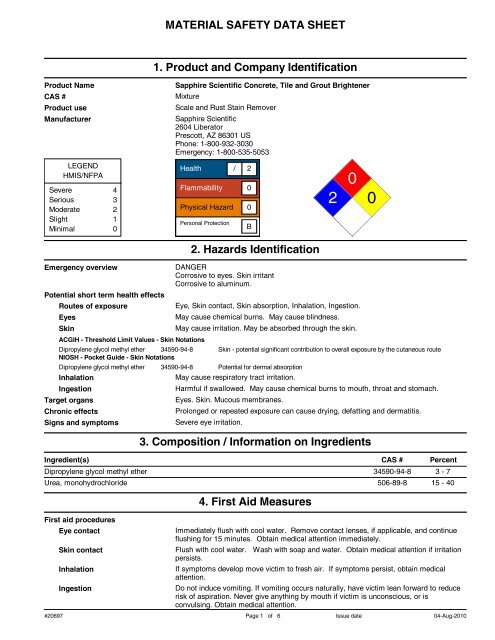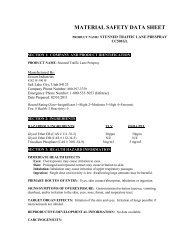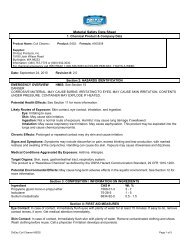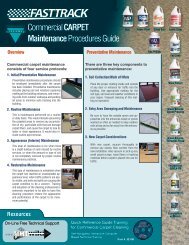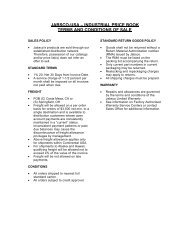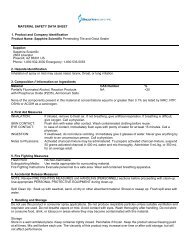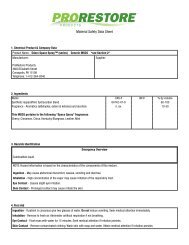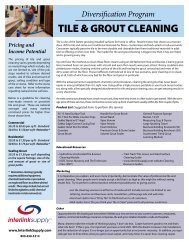Concrete Tile and Grout Brightener English MSDS - Sapphire ...
Concrete Tile and Grout Brightener English MSDS - Sapphire ...
Concrete Tile and Grout Brightener English MSDS - Sapphire ...
Create successful ePaper yourself
Turn your PDF publications into a flip-book with our unique Google optimized e-Paper software.
.<br />
.<br />
.<br />
.<br />
MATERIAL SAFETY DATA SHEET<br />
space<br />
Product Name<br />
space<br />
CAS #<br />
space<br />
Product use<br />
space<br />
Manufacturer<br />
space<br />
LEGEND<br />
HMIS/NFPA<br />
Severe<br />
Serious<br />
Moderate<br />
Slight<br />
Minimal<br />
4<br />
3<br />
2<br />
1<br />
0<br />
1. Product <strong>and</strong> Company Identification<br />
<strong>Sapphire</strong> Scientific <strong>Concrete</strong>, <strong>Tile</strong> <strong>and</strong> <strong>Grout</strong> <strong>Brightener</strong><br />
Mixture<br />
Scale <strong>and</strong> Rust Stain Remover<br />
<strong>Sapphire</strong> Scientific<br />
2604 Liberator<br />
Prescott, AZ 86301 US<br />
Phone: 1-800-932-3030<br />
Emergency: 1-800-535-5053<br />
Health<br />
Flammability<br />
Physical Hazard<br />
Personal Protection<br />
/<br />
2<br />
0<br />
0<br />
B<br />
2. Hazards Identification<br />
0<br />
2 0<br />
space<br />
Emergency overview<br />
space<br />
Potential short term health effects<br />
Routes of exposure<br />
space<br />
Eyes<br />
space<br />
Skin<br />
space<br />
space<br />
space<br />
DANGER<br />
Corrosive to eyes. Skin irritant<br />
Corrosive to aluminum.<br />
Eye, Skin contact, Skin absorption, Inhalation, Ingestion.<br />
May cause chemical burns. May cause blindness.<br />
May cause irritation. May be absorbed through the skin.<br />
ACGIH - Threshold Limit Values - Skin Notations<br />
Dipropylene glycol methyl ether 34590-94-8 Skin - potential significant contribution to overall exposure by the cutaneous route<br />
NIOSH - Pocket Guide - Skin Notations<br />
Dipropylene glycol methyl ether 34590-94-8 Potential for dermal absorption<br />
Inhalation<br />
May cause respiratory tract irritation.<br />
Ingestion<br />
Target organs<br />
space<br />
Chronic effects<br />
space<br />
Signs <strong>and</strong> symptoms<br />
Harmful if swallowed. May cause chemical burns to mouth, throat <strong>and</strong> stomach.<br />
Eyes. Skin. Mucous membranes.<br />
Prolonged or repeated exposure can cause drying, defatting <strong>and</strong> dermatitis.<br />
Severe eye irritation.<br />
3. Composition / Information on Ingredients<br />
space<br />
Ingredient(s) CAS # Percent<br />
Dipropylene glycol methyl ether<br />
34590-94-8 3 - 7<br />
Urea, monohydrochloride<br />
506-89-8 15 - 40<br />
4. First Aid Measures<br />
space<br />
First aid procedures<br />
space<br />
space<br />
space<br />
Eye contact<br />
Skin contact<br />
Inhalation<br />
Ingestion<br />
Immediately flush with cool water. Remove contact lenses, if applicable, <strong>and</strong> continue<br />
flushing for 15 minutes. Obtain medical attention immediately.<br />
Flush with cool water. Wash with soap <strong>and</strong> water. Obtain medical attention if irritation<br />
persists.<br />
If symptoms develop move victim to fresh air. If symptoms persist, obtain medical<br />
attention.<br />
Do not induce vomiting. If vomiting occurs naturally, have victim lean forward to reduce<br />
risk of aspiration. Never give anything by mouth if victim is unconscious, or is<br />
convulsing. Obtain medical attention.<br />
#20697 Page 1 of 6<br />
Issue date<br />
04-Aug-2010
.<br />
.<br />
.<br />
.<br />
space<br />
Notes to physician<br />
space<br />
General advice<br />
Symptoms may be delayed.<br />
If you feel unwell, seek medical advice (show the label where possible). Ensure that<br />
medical personnel are aware of the material(s) involved, <strong>and</strong> take precautions to protect<br />
themselves. Show this safety data sheet to the doctor in attendance. Avoid contact with<br />
eyes <strong>and</strong> skin. Keep out of reach of children.<br />
5. Fire Fighting Measures<br />
space<br />
Flammable properties<br />
space<br />
Not flammable by WHMIS/OSHA criteria.<br />
Extinguishing media<br />
Suitable extinguishing media Dry chemical. Carbon dioxide. Foam. Fog.<br />
space<br />
Unsuitable extinguishing media Not available<br />
space<br />
Protection of firefighters<br />
Specific hazards arising from<br />
the chemical<br />
space<br />
Protective equipment for<br />
firefighters<br />
space<br />
Hazardous combustion products<br />
space<br />
Explosion data<br />
space<br />
Sensitivity to mechanical<br />
impact<br />
Sensitivity to static discharge<br />
Not available<br />
Firefighters should wear full protective clothing including self contained breathing<br />
apparatus.<br />
May include <strong>and</strong> are not limited to: Oxides of carbon. Oxides of nitrogen.<br />
Not available<br />
Not available<br />
6. Accidental Release Measures<br />
space<br />
Personal precautions<br />
space<br />
Methods for containment<br />
space<br />
Methods for cleaning up<br />
space<br />
H<strong>and</strong>ling<br />
space<br />
Storage<br />
space<br />
Exposure limits<br />
Ingredient(s)<br />
Keep unnecessary personnel away. Do not touch or walk through spilled material. Do<br />
not touch damaged containers or spilled material unless wearing appropriate protective<br />
clothing. Keep people away from <strong>and</strong> upwind of spill/leak.<br />
Stop leak if you can do so without risk. Prevent entry into waterways, sewers,<br />
basements or confined areas.<br />
Before attempting clean up, refer to hazard data given above. Small spills may be<br />
absorbed with non-reactive absorbent <strong>and</strong> placed in suitable, covered, labelled<br />
containers. Prevent large spills from entering sewers or waterways. Contact emergency<br />
services <strong>and</strong> supplier for advice. Never return spills in original containers for re-use.<br />
7. H<strong>and</strong>ling <strong>and</strong> Storage<br />
Use good industrial hygiene practices in h<strong>and</strong>ling this material. Do not get this material<br />
in your eyes, on your skin, or on your clothing.<br />
Keep out of the reach of children. Store in a closed container away from incompatible<br />
materials.<br />
8. Exposure Controls / Personal Protection<br />
Exposure Limits<br />
Dipropylene glycol methyl ether<br />
ACGIH-TLV<br />
TWA: 100 ppm<br />
STEL: 150 ppm<br />
Skin: 100 ppm<br />
OSHA-PEL<br />
TWA: 100 ppm<br />
Urea, monohydrochloride<br />
space<br />
Engineering controls<br />
ACGIH-TLV<br />
Not established<br />
OSHA-PEL<br />
Not established<br />
General ventilation normally adequate.<br />
#20697 Page 2 of 6<br />
Issue date<br />
04-Aug-2010
.<br />
.<br />
.<br />
space<br />
Personal protective equipment<br />
space<br />
space<br />
space<br />
space<br />
space<br />
Eye / face protection<br />
H<strong>and</strong> protection<br />
Skin <strong>and</strong> body protection<br />
Respiratory protection<br />
Wear chemical goggles.<br />
Rubber gloves. Confirm with a reputable supplier first.<br />
As required by employer code.<br />
Where exposure guideline levels may be exceeded, use an approved NIOSH respirator.<br />
General hygiene considerations Use good industrial hygiene practices in h<strong>and</strong>ling this material. When using do not eat<br />
or drink. Wash h<strong>and</strong>s before breaks <strong>and</strong> immediately after h<strong>and</strong>ling the product.<br />
Appearance<br />
space<br />
Color<br />
space<br />
Form<br />
space<br />
Odor<br />
space<br />
Odor threshold<br />
space<br />
Physical state<br />
9. Physical <strong>and</strong> Chemical Properties<br />
Clear.<br />
Colourless to light amber<br />
Liquid<br />
Mild<br />
Not available<br />
Liquid<br />
space<br />
pH 0.35<br />
space<br />
Melting point<br />
space<br />
Freezing point<br />
space<br />
Boiling point<br />
space<br />
Pour point<br />
space<br />
Evaporation rate<br />
space<br />
Flash point<br />
space<br />
Auto-ignition temperature<br />
space<br />
Flammability limits in air, lower, %<br />
by volume<br />
space<br />
Flammability limits in air, upper, %<br />
by volume<br />
space<br />
Vapor pressure<br />
space<br />
Vapor density<br />
space<br />
Specific gravity<br />
space<br />
Octanol/water coefficient<br />
space<br />
Percent volatile<br />
Not available<br />
Not available<br />
Not available<br />
Not available<br />
Not available<br />
Not available<br />
Not available<br />
Not available<br />
Not available<br />
Not available<br />
Not available<br />
Not available<br />
Not available<br />
Not available<br />
10. Stability <strong>and</strong> Reactivity<br />
space<br />
Chemical stability<br />
space<br />
Conditions to avoid<br />
space<br />
Incompatible materials<br />
Stable under recommended storage conditions.<br />
Do not mix with other chemicals.<br />
Caustics. Oxidizers. Reducing agents.<br />
space<br />
Hazardous decomposition products May include <strong>and</strong> are not limited to: Oxides of carbon. Oxides of nitrogen.<br />
space<br />
Possibility of hazardous reactions<br />
Hazardous polymerization does not occur.<br />
11. Toxicological Information<br />
space<br />
Component analysis - LC50<br />
Ingredient(s)<br />
Dipropylene glycol methyl ether<br />
Urea, monohydrochloride<br />
space<br />
Component analysis - Oral LD50<br />
Ingredient(s)<br />
Dipropylene glycol methyl ether<br />
Urea, monohydrochloride<br />
space<br />
Effects of acute exposure<br />
Eye<br />
LC50<br />
Not available<br />
Not available<br />
LD50<br />
5400 mg/kg rat<br />
1121 mg/kg rat<br />
May cause chemical burns. May cause blindness.<br />
#20697 Page 3 of 6<br />
Issue date<br />
04-Aug-2010
.<br />
.<br />
.<br />
space<br />
space<br />
space<br />
space<br />
Skin<br />
May cause irritation. May be absorbed through the skin.<br />
ACGIH - Threshold Limit Values - Skin Notations<br />
Dipropylene glycol methyl ether 34590-94-8 Skin - potential significant contribution to overall exposure by the cutaneous route<br />
NIOSH - Pocket Guide - Skin Notations<br />
Dipropylene glycol methyl ether 34590-94-8 Potential for dermal absorption<br />
Inhalation<br />
May cause respiratory tract irritation.<br />
Ingestion<br />
Sensitization<br />
space<br />
Chronic effects<br />
space<br />
Carcinogenicity<br />
space<br />
Mutagenicity<br />
space<br />
Reproductive effects<br />
space<br />
Teratogenicity<br />
space<br />
Synergistic Materials<br />
space<br />
Ecotoxicity<br />
Harmful if swallowed. May cause chemical burns to mouth, throat <strong>and</strong> stomach.<br />
Non-hazardous by WHMIS/OSHA criteria.<br />
Non-hazardous by WHMIS/OSHA criteria.<br />
Non-hazardous by WHMIS/OSHA criteria.<br />
Non-hazardous by WHMIS/OSHA criteria.<br />
Non-hazardous by WHMIS/OSHA criteria.<br />
Non-hazardous by WHMIS/OSHA criteria.<br />
Not available<br />
12. Ecological Information<br />
Components of this product have been identified as having potential environmental<br />
concerns.<br />
Ecotoxicity - Freshwater Fish Species Data<br />
Dipropylene glycol methyl ether 34590-94-8 96 Hr LC50 Pimephales promelas: >10000 mg/L [static]<br />
Ecotoxicity - Water Flea Data<br />
Dipropylene glycol methyl ether 34590-94-8 48 Hr LC50 Daphnia magna: 1919 mg/L<br />
space<br />
Environmental effects<br />
Not available<br />
space<br />
Aquatic toxicity<br />
space<br />
Persistence / degradability<br />
space<br />
Bioaccumulation / accumulation<br />
space<br />
Partition coefficient<br />
space<br />
Mobility in environmental media<br />
space<br />
Chemical fate information<br />
space<br />
Other adverse effects<br />
Not available<br />
Not available<br />
Not available<br />
Not available<br />
Not available<br />
Not available<br />
Not available<br />
13. Disposal Considerations<br />
space<br />
Waste codes<br />
space<br />
Disposal instructions<br />
space<br />
Waste from residues / unused<br />
products<br />
space<br />
Contaminated packaging<br />
Not available<br />
Review federal, state/provincial, <strong>and</strong> local government requirements prior to disposal.<br />
Not available<br />
Not available<br />
14. Transport Information<br />
space<br />
U.S. Department of Transportation (DOT)<br />
Not regulated as dangerous goods.<br />
space<br />
Transportation of Dangerous Goods (TDG - Canada)<br />
Basic shipping requirements:<br />
Proper shipping name<br />
CORROSIVE LIQUID, ACIDIC, ORGANIC, N.O.S.,<br />
SOLUTION (Urea, monohydrochloride)<br />
Hazard class<br />
UN number<br />
Packing group<br />
Additional information:<br />
Special provisions<br />
8<br />
UN3265<br />
III<br />
16<br />
#20697 Page 4 of 6<br />
Issue date<br />
04-Aug-2010
.<br />
15. Regulatory Information<br />
space<br />
Canadian federal regulations This product has been classified in accordance with the hazard criteria of the Controlled<br />
Products Regulations <strong>and</strong> the <strong>MSDS</strong> contains all the information required by the<br />
Controlled Products Regulations.<br />
Canada - WHMIS - Ingredient Disclosure List<br />
Dipropylene glycol methyl ether 34590-94-8 1 %<br />
space<br />
US Federal regulations<br />
This product is a "Hazardous Chemical" as defined by the OSHA Hazard<br />
Communication St<strong>and</strong>ard, 29 CFR 1910.1200.<br />
CERCLA/SARA Hazardous Substances - Not applicable.<br />
space<br />
Occupational Safety <strong>and</strong> Health Administration (OSHA)<br />
29 CFR 1910.1200 hazardous Yes<br />
chemical<br />
space<br />
CERCLA (Superfund) reportable quantity<br />
None<br />
space<br />
Superfund Amendments <strong>and</strong> Reauthorization Act of 1986 (SARA)<br />
Hazard categories<br />
Immediate Hazard - Yes<br />
Delayed Hazard - No<br />
Fire Hazard - No<br />
Pressure Hazard - No<br />
Reactivity Hazard - No<br />
space<br />
Section 302 extremely<br />
No<br />
hazardous substance<br />
space<br />
space<br />
Section 311 hazardous chemical Yes<br />
Clean Air Act (CAA)<br />
space<br />
Clean Water Act (CWA)<br />
space<br />
WHMIS status<br />
space<br />
WHMIS classification<br />
space<br />
WHMIS labeling<br />
Not available<br />
Not available<br />
Controlled<br />
Class D - Division 2B, Class E - Corrosive Material<br />
space<br />
space<br />
State regulations<br />
This product does not contain a chemical known to the State of California to cause<br />
cancer, birth defects or other reproductive harm.<br />
U.S. - California - 8 CCR Section 339 - Director's List of Hazardous Substances<br />
Dipropylene glycol methyl ether 34590-94-8 Present<br />
U.S. - Massachusetts - Right To Know List<br />
Dipropylene glycol methyl ether 34590-94-8 Present<br />
U.S. - Minnesota - Hazardous Substance List<br />
Dipropylene glycol methyl ether 34590-94-8 Present<br />
U.S. - New Jersey - Right to Know Hazardous Substance List<br />
Dipropylene glycol methyl ether 34590-94-8 sn 0804<br />
U.S. - Pennsylvania - RTK (Right to Know) List<br />
Dipropylene glycol methyl ether 34590-94-8 Present<br />
U.S. - Rhode Isl<strong>and</strong> - Hazardous Substance List<br />
Dipropylene glycol methyl ether 34590-94-8 Toxic<br />
Inventory name<br />
Country(s) or region Inventory name On inventory (yes/no)*<br />
Canada Domestic Substances List (DSL) Yes<br />
Canada<br />
Non-Domestic Substances List (NDSL)<br />
No<br />
United States & Puerto Rico Toxic Substances Control Act (TSCA) Inventory<br />
Yes<br />
A "Yes" indicates that all components of this product comply with the inventory requirements administered by the governing country(s)<br />
#20697 Page 5 of 6<br />
Issue date<br />
04-Aug-2010
.<br />
16. Other Information<br />
space<br />
Disclaimer<br />
space<br />
Issue date<br />
space<br />
Effective date<br />
space<br />
Expiry date<br />
Information contained herein was obtained from sources considered technically accurate<br />
<strong>and</strong> reliable. While every effort has been made to ensure full disclosure of product<br />
hazards, in some cases data is not available <strong>and</strong> is so stated. Since conditions of actual<br />
product use are beyond control of the supplier, it is assumed that users of this material<br />
have been fully trained according to the requirements of all applicable legislation <strong>and</strong><br />
regulatory instruments. No warranty, expressed or implied, is made <strong>and</strong> supplier will not<br />
be liable for any losses, injuries or consequential damages which may result from the<br />
use of or reliance on any information contained in this document.<br />
04-Aug-2010<br />
01-Aug-2010<br />
01-Aug-2013<br />
space<br />
Prepared by Dell Tech Laboratories Ltd. (519) 858-5021<br />
space<br />
Other information<br />
For an updated <strong>MSDS</strong>, please contact the supplier/manufacturer listed on the first<br />
page of the document.<br />
#20697 Page 6 of 6<br />
Issue date<br />
04-Aug-2010


